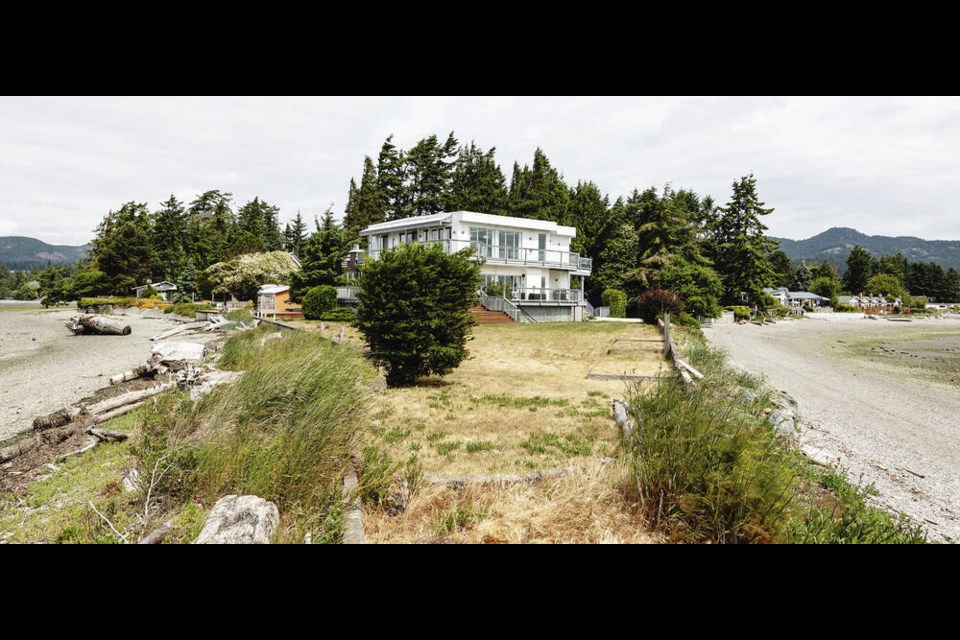Waterfront property owners packed Sooke council chambers on Monday afternoon to voice opposition to a proposal to restrict new development in a 15-metre zone above the high-tide mark.
The measure, intended to protect the foreshore, is included as part of a draft revision to the municipality’s official community plan, which has been in the works since 2016.
Facing a standing-room-only council chamber, Sooke Mayor Maja Tait said council has no intention of expropriating anyone’s property for a boardwalk or otherwise.
“There was a letter taped to a tree somewhere about [how] we’re taking the entire shoreline of Sooke and that was a bit of a shocker to me,” Tait told the Times Colonist prior to the meeting. “There’s no intention of expropriating land to put in a boardwalk. I don’t know where that came from.”
Tait said any waterfront trail is at this point only an idea and would likely be at least 50 years away.
Local developer Randy Clarkston, who could not be reached for comment Monday, has been circulating letters calling on waterfront property owners to oppose the OCP draft, and in particular, the proposed regulation of new development above the foreshore area — the Crown-owned land between the high and low tidelines.
Clarkston’s letter called the proposal an attack on the property rights of waterfront homeowners.
Dozens of homeowners wrote to council opposing the OCP with variations of a form letter provided by Clarkston.
Sooke waterfront property owner Doug Bexson told council Monday that the idea of providing public access to the waterfront, while well-intentioned and well-meaning, has been taken too far.
“It causes myself, my family, and a host of others considerable concern,” Bexson said. “It’s an unwarranted regulation.”
The OCP is also encouraging the use of softer shoreline protection methods such as planting beach vegetation instead of building retaining walls and seawalls.
Sooke staff said the proposed 15-metre setback would not apply to existing waterfront properties unless the owner applies for a development permit.
“You will not have to obtain a permit or pay fees, or hire anyone to trim trees or plant shrubs,” Tait said, adding that the guidelines are meant to target new multi-family housing or other proposed developments that might require land assembly.
Staff came to the meeting with a 10-point slide presentation to counter the misinformation they said was circulating among Sooke residents, noting the requirement of a 15-metre setback would not apply to any existing single-family homes, duplexes, farms, or accessory buildings.
Similarly, property owners would not be restricted from maintaining or repairing any existing permanent infrastructure, including seawalls and docks.
Sooke’s proposed foreshore requirements are similar to foreshore setback requirements in West Vancouver that were adopted last year. A similar setback regulation is already in effect for riparian areas in Sooke.
“The expropriation thing was particularly funny to me because we have almost no money to do anything without raising taxes,” Coun. Tony St-Pierre said Monday. “We would get lynched if we tried to expropriate — in terms of how much we would have to raise taxes — to pay for anything.”
Sooke’s foreshore setback has already been reduced; council halved the provincially recommended setback of 30 metres to 15 in March of last year.
Lorraine Pawlivksy-Love, owner of a waterfront farm-stay property in Sooke, said that she is concerned that the new regulations will lower property values. “I think they need some really good legal counsel before they go forward on this,” she said.
But one commentator watching the council livestream had a different idea, writing in an online chat: “The biggest issue in Sooke is [that] they can’t subdivide to make another million dollars? These people are funny.”
Another council meeting dedicated to discussing the official community plan is expected to be held July 17.
Tait said that she welcomed Monday’s meeting as an opportunity to clarify and improve upon the language in the document, which is expected to set the direction of the community for the next 10 years.
A final draft of the official community plan will have to wait until at least this fall, when the provincial government is expected to table its Housing Supply Act, which is expected to have ramifications for housing targets and governance at the municipal level, she said.
>>> To comment on this article, write a letter to the editor: [email protected]



